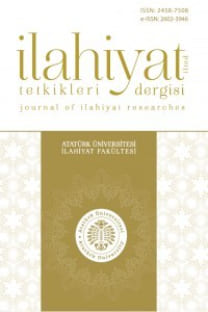BEDRUDDÎN EL-‘AYNÎ’YE GÖRE HADİSLERDE HASR USLÛBUNUN KULLANIMI VE MÂNÂYA ETKİSİ (‘UMDETU’L-KÂRÎ ÖZELİNDE)
/ According to Bedruddîn el-‘Aynî, Using of Restriction Style in Hadiths and its Effect on Meaning (Specific to ‘Umdetu’l-Kârî)
Hadith, language, meaning, restriction, oratory,
___
- ‘Aynî, Bedrûddîn Ebî Muhammed Mahmûd b. Ahmed, ‘Umdetu’l-Kârî Şerhu Sahîhi’l- Buhârî, (tsh. Abdullah Mahmûd Muhammed Ömer), Dâru’l-Kütübi’l-İlmiyye, Beyrût 1421/2001.
- Akdemir, Hikmet, Belâgat Terimleri Ansiklopedisi, Nil yay., İzmir 1999.
- Askerî, M. Salih Şerîf, “el-İstişhâd bi’l-hadisi’n-nebeviyyi’ş-şerîf ‘ınde’l-lugaviyyîn”, Âfâkı’l-Hadârati’l-İslâmiyye, Akademiyyetu’l-ulûmi’l-insâniyye ve’d-dirâsâti’s-sikâfiyye, es-Senetü’s-sâlisetu aşera, el-Adedu’d-sânî, Harîf ve Şitâ, 1431, s. 97-113.
- Azîmâbâdî, Ebu’t-Tayyib Muhammed Şemsu’l-hak, Avnu’l-ma’bûd şerhu Sünen-i Ebî Dâvûd, Dâru’l-kütübi’l-ilmiyye, Beyrût, 1410/1990.
- Bağdâdî, Abdulkâdir b. Ömer, Hızânetu’l-edeb velübbü lübâbi lisâni’l-arab, thk. A. Muhammed Harun, Mektebetu’l-Hancî, Kahire 1418/1997.
- Bilgegil, M. Kaya, Edebiyat Bilgi ve Teorileri, Enderun Kitabevi, İstanbul, 1989.
- Bolelli, Nusrettin, “Nahivde İstişhad Meselesi”, Marmara Üniversitesi İlahiyat Fakül- tesi Dirgisi, Sayı:5-6, İstanbul, 1993, 165-175.
- ____________, Belâgat, MÜİF Vakfı yay., İstanbul, 2009.
- Buhârî, Ebû Abdullah Muhammed b. İsmâil, el-Câmiu’s-Sahîh, nşr. Bedreddin Çetin- er, Çağrı yay., İstanbul, 1992.
- Canan, İbrahim, Kütüb-i Sitte Tercüme ve Şerhi, Akcağ yay., İstanbul, 1995, XVI, 114.
- Celîdân, M. Sâlim İbrahim, Bedruddîn el-Aynî ve menhecuhu’n-nahvî fî kitâbi- hî ‘Umdetu’l-kârî şerhu Sahîhi’l-Buhârî, (Risâletu’l-macistîr), el-Câmiatu’l-islâmiyye Külliyetu’l-âdâb, Gazze 1430/2009.
- Civelek, Yakup, Ünlüer, Ceyhun, “Bedruddîn Aynî’ye Göre Arap Nahiv Usûlü ve İstişhâd (Umdetu’l-Kârî Örneği Bağlamında)”, Uluslararası Bedruddîn el-Aynî Sempozyu- mu ve II. Hadis İhtisas Toplantısı, Gaziantep, 2013, s. 451-466.
- Curcânî (v. 816), Ali b. Muhammed es-Seyyid, Mu’cemu’t-Ta’rifât, thk. M. Sıddîk el- Minşâvî, Dâru’l-fazîle, Kahire, ty.
- Dırâz, Sabbâh Abîd, Esâlîbu’l-kasr fi’l-Kur’âni’l-Kerîm, Matbaatu’l-emâne, Mısır, 1406/1987.
- Durmuş, İsmail, “Hasr” md., DİA, TDV yay., İstanbul, 1997.
- Ebu’l-Bekâ, Eyyûb b. Mûsâ el-Huseynî (1094), el-Külliyât, haz. Adnân Dervîş, Mu- hammed el-Mısrî, Muessesetu’r-risâle, ty.
- Ebû Davûd, Süleyman b. el-Eş‘âs, es-Sunen, nşr. Bedreddin Çetiner, Çağrı yay., İstanbul, 1992.
- Ebû Zehv, M. Muhammed, el-Hadîs ve’l-muhaddisûn, er-Riâsetu’l-âmme li-idâreti’l- buhûsi’l-ilmiyye, Riyâd, 1404/1984.
- Feccâl, Mahmûd, es-Siyeru’l-hasîs ile’l-istişhâd bi’l-hadîs fi’n-nahvi’l-arabî, Edvâu’s-selef, 1417.
- _____________, el-Hadîsu’n-nebevî fi’n-nahvi’l-arabî, Edvâu’s-selef, 1417/1997.
- Fîrûzâbâdî (v. 817), Mecduddîn Muhammed b. Yakûb, el-Kâmûsu’l-muhît, Dâru’l- hadis, Kahire, 1429/2008.
- Fukeyr, Ahmed b. Muhammed, “Hadisleri anlamada bütüncül yaklaşım”, çev.
- ISSN: 2458-7508
- Yayın Aralığı: 2
- Başlangıç: 1975
- Yayıncı: Atatürk Üniversitesi
SABIR ÖLÇEĞİNİN TÜRKÇEYE UYARLANMASI: GEÇERLİK VE GÜVENİRLİK ÇALIŞMASI
LEZGİ DİLİNDEKİ ARAPÇA ÖDÜNÇLEMELER VE MORFOLOJİK YAPILARI
KUR’ÂN VE HADİSLERE GÖRE “KALEM” KAVRAMI
HIRİSTİYANLIĞA AKTARILMIŞ RİTÜELLER OLARAK İSİS KÜLTÜNDEKİ VAFTİZ VE GÜNAH ÇIKARTMA AYİNLERİ
KUR'ÂN'DA “ كَلَّا ” KELLÂ EDATI
AHMED B. HANBEL’İN FAKİHLİĞİYLE İLGİLİ TARTIŞMALAR
İBN ŞENEBÛZ: HAYATI, KIRÂAT İLMİNDEKİ YERİ VE RESMİ HATTA MUHALİF OKUYUŞLARI
MÛSÂ CÂRULLÂH’IN TÂRÎHU’L-KUR’ÂN VE’L-MESÂHIF ADLI ESERİ VE TEFSÎR İLMİ AÇISINDAN DEĞERİ
